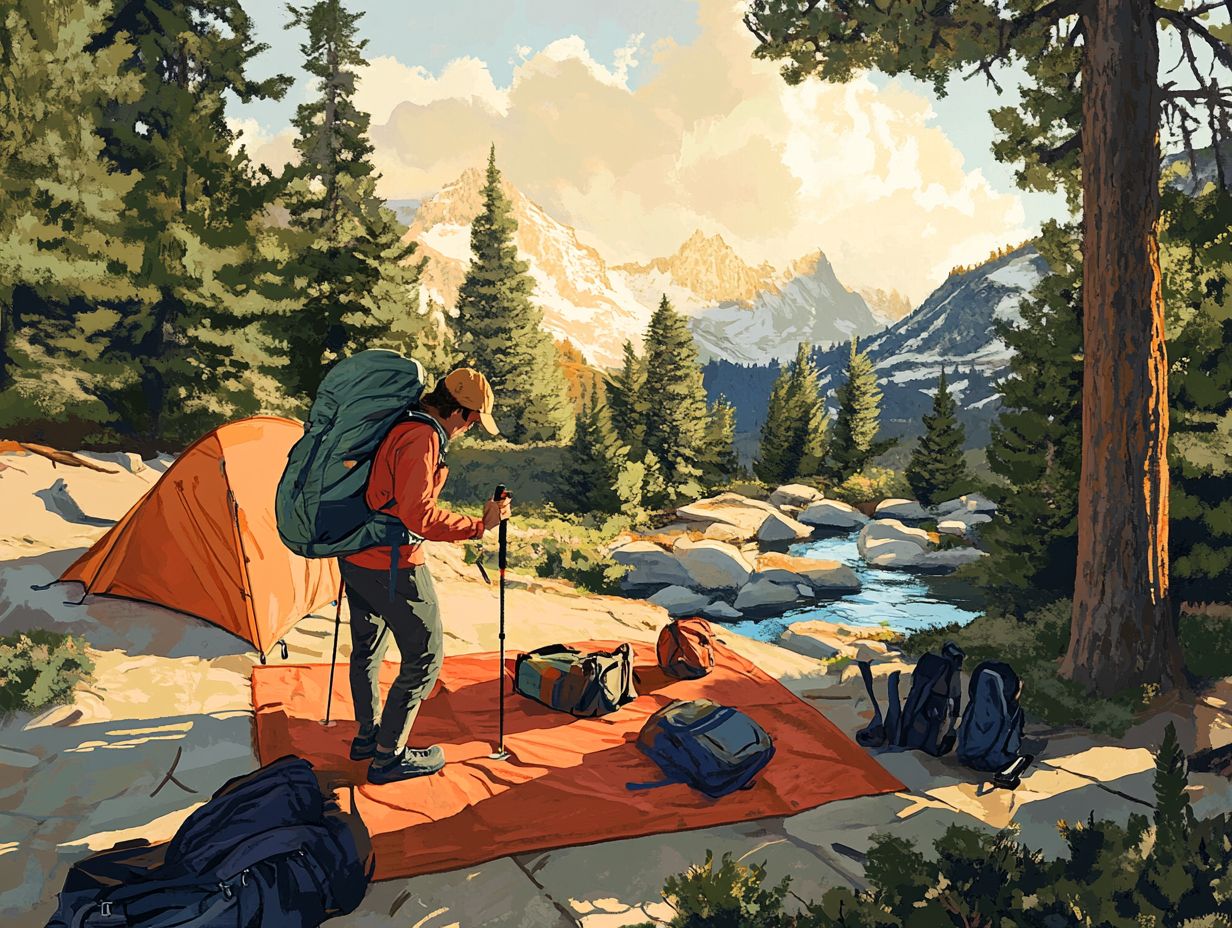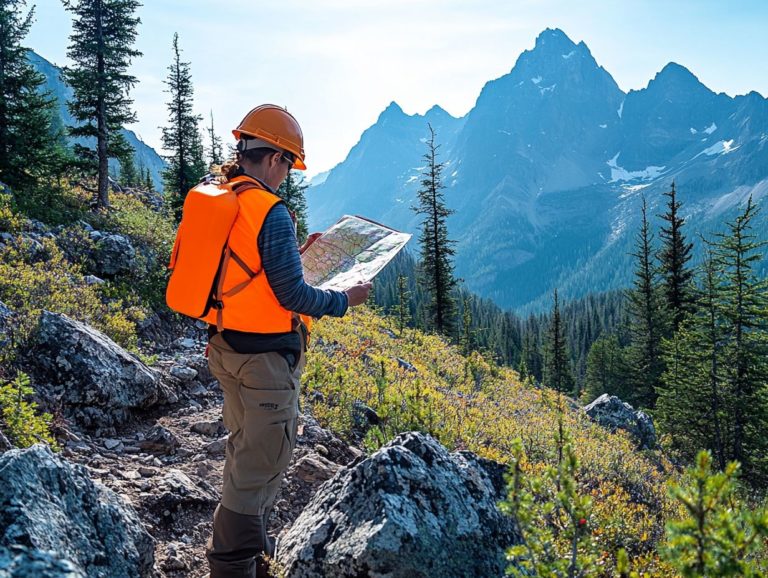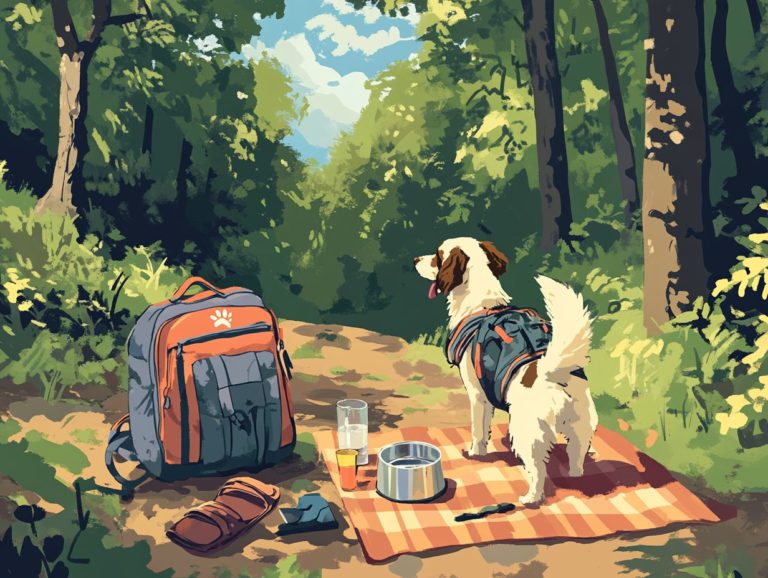How to Pack a Backpack for Hiking
Embarking on a hike can be one of the most exhilarating experiences, but the key to fully enjoying the great outdoors lies in your preparation beginning with your backpack.
From selecting the right pack to packing essential items and mastering weight distribution, this guide equips you with everything necessary for a successful hiking adventure.
Tips for comfort, convenience, and emergency preparedness will ensure that you re ready for both day hikes and overnight excursions.
Prepare to hit the trails with confidence!
Contents
- Key Takeaways:
- Choosing the Right Backpack
- Essential Items to Pack
- Organizing and Distributing Weight
- Tips for Comfort and Convenience
- Preparing for Emergencies
- Key Tips for Different Hiking Adventures
- Frequently Asked Questions
- What are the essential items to pack in a backpack for hiking?
- How should I organize my backpack when packing for a hike?
- How much weight should my backpack be when hiking?
- Can I pack perishable foods in my backpack for a hike?
- Should I pack any emergency supplies in my backpack for a hike?
- How can I ensure my backpack is comfortable to carry while hiking?
Key Takeaways:

- Choose a backpack that is the right size and style for your hiking needs.
- Pack essential items, including appropriate clothing and gear, according to a checklist.
- Organize and distribute weight properly in your backpack to reduce strain and improve accessibility.
Choosing the Right Backpack
Your choice of backpack is key to a great hike. It can truly change how you feel on the trail. Whether you re an experienced hiker or a beginner gearing up for an adventure on the Pacific Crest Trail or Te Araroa, selecting a backpack that aligns with your needs in terms of capacity, comfort, and features is essential.
A standout option is the Osprey Exos 48, which masterfully blends a lightweight design with generous storage options, including pockets for easy organization and a waterproof pack liner to guard against unexpected rain.
Remember to include your hiking poles and other camping gear to elevate your preparation even further.
Factors to Consider
When selecting the perfect backpack for your hiking adventure, several important factors to consider include weight, capacity, fit, and organization. A well-fitted backpack not only enhances your comfort but also ensures that weight is evenly distributed, allowing you to carry essential items without straining your back or shoulders.
The weight of the backpack itself is paramount; a lighter pack can significantly diminish fatigue on long treks. Look for options crafted from durable yet lightweight materials.
Capacity is just as vital consider how much gear you ll need to carry, ensuring the backpack can accommodate it without becoming cumbersome.
A proper fit is crucial. Adjustable straps and a hip belt can make all the difference, catering to your unique body type and ensuring a snug yet comfortable carry.
To evaluate organization, look for multiple compartments and pockets that provide easy access to frequently used items. Try on various models loaded with gear to truly understand how they feel and make necessary adjustments for the best experience.
Essential Items to Pack
Packing the right essential items is vital for your hiking trip, ensuring both safety and enjoyment in the great outdoors. From food and gear to hydration systems, having a carefully curated hiking checklist can transform your journey from a mere outing into a delightful adventure.
Essential equipment like a first aid kit, lightweight clothing, and a suitable sleeping bag should be meticulously chosen to align with the conditions of your hiking trail, whether you re embarking on a day hike or an overnight camping excursion.
Clothing and Gear Checklist
When preparing for your hike, it s essential to create a clothing and gear checklist tailored to the weather conditions and duration of your trip. To ensure your comfort and safety, consider packing clothing in layers. Start with moisture-wicking base layers clothes that draw sweat away from your body add insulating middle layers, and top it off with an outer rain jacket to shield against unexpected weather changes.
In addition to these foundational pieces, think about including lightweight fleece jackets and breathable pants to enhance your mobility and warmth. Waterproof hiking boots are also crucial; they ll keep your feet dry and supported as you navigate rugged trails.
For added convenience, use packing cubes or compression bags to keep everything organized and easily accessible. A well-structured backpack can make a significant difference in your hiking experience; choose one with external pockets for quick access to essentials like snacks and maps, and ensure it has adjustable straps to distribute weight evenly throughout your adventure. To enhance your preparation, refer to this guide on how to plan a multi-day hike.
Get ready for an adventure! Start planning your hiking adventure today and explore the beauty of nature!
Organizing and Distributing Weight

Properly organizing and distributing weight in your backpack is essential for a balanced system that enhances your hiking comfort and safety. Master the art of packing your essential items like food and gear to optimize storage and alleviate strain on your body. This transformation will significantly enhance the enjoyment of your adventure.
Place heavier items closer to your back. Utilize different pockets and compartments to maintain balance throughout your journey. For more tips, check out this guide on how to prepare for a long hike.
Proper Packing Techniques
Effective packing techniques can elevate your hiking experience by keeping your gear organized and easy to access. Use compression straps the straps that help tighten your gear and lightweight packing methods to maximize space in your backpack. This way, you can fit all the essentials while keeping your load manageable on the trail.
Strategically organizing your gear enhances ease of access during breaks and promotes balance, which is vital for comfort on uneven terrains. For instance, using compression bags can significantly reduce the volume of clothing and soft items, creating space for bulkier equipment.
When planning for different hikes, tailor your packing strategies to the trail’s length and difficulty. Keep essential items within easy reach while positioning heavier gear lower for better stability. Mindful packing turns any trek into a more enjoyable adventure.
Tips for Comfort and Convenience
Comfort and convenience are crucial for an enjoyable hiking experience, especially on extended trails.
- Stay hydrated.
- Choose the right clothing.
- Adjust your backpack for a proper fit.
These simple tips can make a world of difference in reducing strain on your body, ultimately enhancing your hiking adventure. Make sure your essentials are easily accessible, allowing you to focus on the beauty of nature around you instead of fumbling with your gear.
How to Reduce Strain and Improve Accessibility
To reduce strain during your hike and ensure easy access to your essential items, prioritize lightweight gear and achieve a proper backpack fit. Incorporate hiking poles for stability and support, allowing you to navigate trails with greater ease while minimizing fatigue.
Select equipment that is both lightweight and suitable for your terrain. Choose a well-fitted backpack that rests comfortably against your back, distributing weight evenly to prevent stress on your shoulders.
Adjust your hiking poles to the correct height to promote a natural stride and reduce joint impact. By taking a thoughtful approach to gear selection, fit, and usage, you will greatly enhance your comfort and enjoyment on the trail.
Preparing for Emergencies
Preparing for emergencies while hiking is crucial for your safety and well-being in the great outdoors. Carry a well-stocked first aid kit and familiarize yourself with emergency protocols to elevate your readiness for unforeseen circumstances.
Whether embarking on a short day hike or an extended overnight camping trip, this preparation is your ticket to a safe and thrilling adventure!
Take action today and prepare your own emergency kit.
Emergency Supplies and Protocols

When you prepare for a hiking trip, having the right emergency supplies can be a game-changer for your safety. It can help you handle unexpected situations. A comprehensive first aid kit is essential, and being equipped with knowledge on how to manage common hiking emergencies like injuries, getting lost, or sudden weather changes can make all the difference.
Pack essential supplies like a reliable map and compass for navigation, a versatile multi-tool for various tasks, and weather-appropriate clothing to protect yourself from temperature swings. It’s also wise to bring along extra food, water, a flashlight, and a whistle to signal for help if needed. Additionally, consider what makes a good backpack for hiking to ensure you’re well-equipped for your adventure.
Familiarizing yourself with basic safety protocols like recognizing trail markers, informing someone of your trip itinerary, and staying calm during unexpected events can significantly boost your preparedness.
In the end, having a well-thought-out plan not only instills confidence but also reduces risks. Turn an ordinary hike into an unforgettable adventure today!
Key Tips for Different Hiking Adventures
Grasping the nuances between different types of hikes is essential for ensuring you re well-prepared and adequately packed.
Day hikes generally call for minimal gear, allowing you to focus on lightweight essentials. In contrast, overnight hikes necessitate more thorough planning, including camping equipment, food provisions, and a comfortable sleeping bag.
Each hiking experience presents its own challenges and opportunities, making it crucial for you to customize your packing strategy for a successful adventure.
Day Hikes vs. Overnight Hikes
Day hikes and overnight hikes require distinct strategies for planning and packing. It s essential to understand the basics for both.
On a day hike, you’ll typically need the basics—think food, hydration, and a rain jacket. However, for overnight hikes, you’ll need to up your game with camping gear like a tent, sleeping bag, and cooking supplies. It’s also important to learn how to protect your gear while hiking to ensure everything stays in great condition.
For day hikes, focus on lightweight and portable gear. This allows you to enjoy the trails without feeling weighed down. To ensure you have everything you need, check out what to pack for a day hike. Conversely, preparing for overnight hikes means considering the volume and weight of your gear, as you’ll be carrying supplies for multiple days, including sleeping arrangements and food, as well as crucial safety items like first-aid kits and navigation tools.
Grasping the unique requirements of each hike type is vital to ensure your comfort and safety. This highlights the importance of thorough preparation, whether you’re embarking on a brief outing or an extended adventure.
Frequently Asked Questions
What are the essential items to pack in a backpack for hiking?
Don t forget these must-haves for your hiking backpack: a first aid kit, straps that help hold your gear in place, extra clothing layers, food, water, a map, a headlamp, and a fire starter.
How should I organize my backpack when packing for a hike?

Organize your backpack by placing heavy items at the bottom, followed by medium-weight items, and then lighter items on top. This will help distribute the weight evenly and prevent strain on your back.
How much weight should my backpack be when hiking?
The recommended weight for a backpack when hiking is no more than 20-25% of your body weight. This will reduce the risk of injury and fatigue during your hike.
Can I pack perishable foods in my backpack for a hike?
It’s not recommended to pack perishable foods in your backpack for a hike, as they can spoil quickly and cause food poisoning. Stick to non-perishable snacks like trail mix, energy bars, and dried fruits.
Should I pack any emergency supplies in my backpack for a hike?
Absolutely! Being prepared for emergencies is crucial when hiking. Pack essential items like a first aid kit, a map, a whistle, and a fire starter to handle unexpected situations.
How can I ensure my backpack is comfortable to carry while hiking?
To keep your backpack comfortable, adjust the straps to fit your body. Pack it evenly and avoid overpacking to prevent strain on your back.





